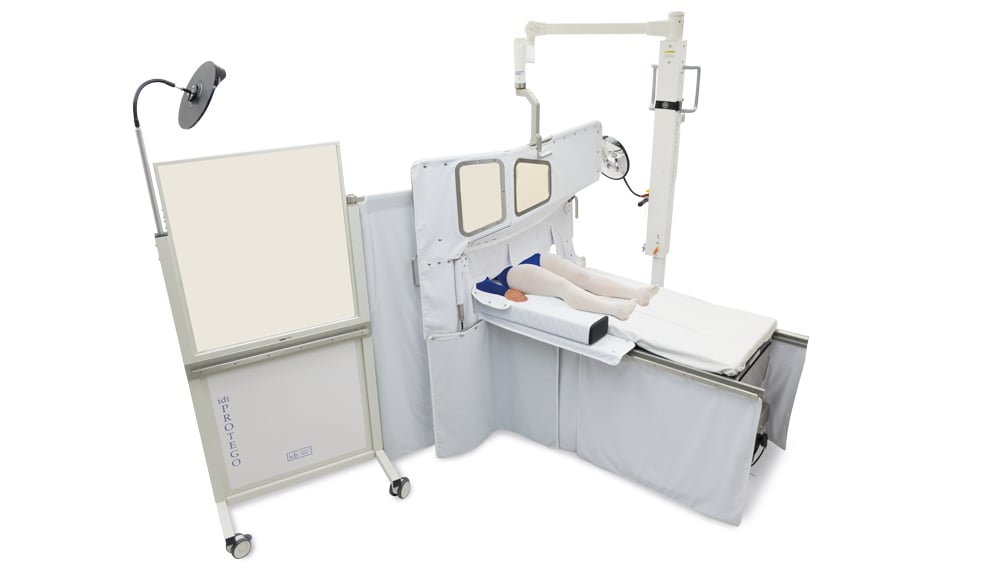
[ad_1]
November 5, 2021 – An FDA-approved device used during cardiac cath lab procedures cut radiation exposure for cardiologists, nurses and other medical staff in half, according to a study conducted by Beaumont Health, the largest health system in Michigan.
The ControlRad device collimates the area of interest where the physicians are working, and reduces the dose significantly to peripheral areas in the image. This reduces exposure to ionizing X-ray radiation from the imaging system. It is one of two new radiation protection systems used at Beaumont.
The study results were presented Nov. 5 at the Cardiovascular Research Foundation’s Transcatheter Cardiovascular Therapeutics (TCT) 2021 conference in Orlando.
“For medical team members doing cath lab procedures, radiation exposure over days, weeks and years is a serious health concern as they take care of patients,” said Beaumont Health interventional cardiologist Dr. Simon Dixon, MBChB, chairman, Department of Cardiovascular Medicine, Beaumont Hospital, Royal Oak, and the Dorothy Susan Timmis Endowed Chair of Cardiology, who presented the study results at TCT. “Mitigating that exposure can help reduce health care workers’ higher incidence of cancer and cataracts over their lifetime.”
Radiation exposure in the cath lab can lead to a higher risk of head and neck cancers and cataracts. Heavy, lead-lined aprons worn in the cath lab to protect against radiation can also lead to chronic back issues for busy cardiologists and their staff.
Interventional cardiologists perform procedures guided by angiographic X-ray imaging. The issue of radiation exposure is so critical that federal guidelines require cath lab workers to wear radiation-detecting badges to monitor their exposure and stop performing procedures if they reach a certain threshold that puts them at higher risk for medical issues.
The ControlRad device, approved for commercial cath lab use by the FDA in December 2020, is retrofitted to X-ray equipment in the catheterization lab. It creates a type of aperture that collimates the image area being viewed. By using a touch pad, the cardiologist controls the aperture to narrow or widen the field of view on the X-ray, which in turn reduces the amount of radiation used to produce the images.
For the study, cath lab workers wore radiation-detecting badges near their thyroid and inside their lead apron during procedures. Another badge was placed on a wall inside the lab. The study detected a 55% to 57% decrease in radiation exposure at the thyroid position of the main cardiologist, or lead operator, and a 49% decrease in radiation exposure to the cardiologist assisting, or operator 2. The badge on the wall detected a 38% decrease in radiation exposure.
“If a nurse or tech is standing at the wall, that’s a nearly 40% decrease in radiation exposure,” Dixon said. “Radiation exposure for the cardiologist is a real concern, but so is exposure for staff. Cath lab nurses, anesthesiologists, physician assistants and others go into case after case as the doctors rotate. Protecting them is a real challenge.”
Staff at Beaumont Hospital, Royal Oak, are also studying another radiation protection device, the Protego barrier system. The Protego system places a barrier wall between the imaging equipment and the operator and staff. While it does not protect the patient from radiation during their procedure, it is designed to allow staff to work in the cath lab without wearing a heavy lead apron.

The Protego Radiation protection barrier system allows interventional cardiologists to work with out the need to wear lead aprons.
According to an abstract published in May 2021 in the peer-reviewed journal Cardiovascular Revascularization Medicine (CRM), a pre-clinical study of the system showed a 94% reduction in radiation throughout the cath lab, and a 97.8% to 99.8% reduction in radiation exposure for the main doctor, or primary operator.
“Years of working in the cath lab wearing a heavy lead apron has really affected my back, compressing it by more than an inch,” said Beaumont interventional cardiologist Maher Rabah, DO, director of the cardiac catheterization lab at Beaumont Hospital, Royal Oak. He has been using the system as he unblocks vessels or stents blockages in percutaneous coronary interventions (PCI). “Combined with the long-term effects of exposure to radiation, anything we can do to help limit issues for the medical staff is a step forward in providing compassionate, extraordinary care for all.”
Related Content on Reducing Radiation in the Interventional Lab:
14 Ways to Reduce Radiation Exposure in the Cath Lab
VIDEO: Technologies and Techniques to Reduce Radiation Dose in the Cardiac Cath Lab — Interview with Akshay Khandelwal, M.D.
VIDEO: Reducing Cath Lab Radiation Dose at Henry Ford Hospital
5 Technologies to Reduce Cath Lab Radiation Exposure
VIDEO: Heart Surgeon Shares Effects of Fluoroscopic Radiation Exposure
[ad_2]
Source link